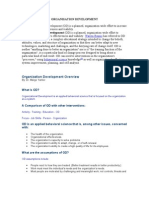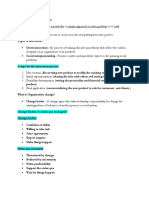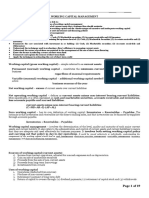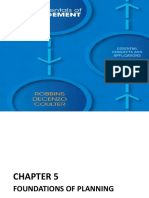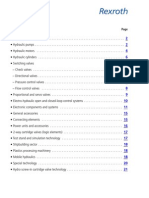0 ratings0% found this document useful (0 votes)
284 viewsChapter 3 Integrative Managerial Issues
Chapter 3 Integrative Managerial Issues
Uploaded by
Niz IsmailFundamentals of Management: Essential Concepts and Applications (8/E)
by: Robbins, Decenzo, & Coulter
Copyright:
© All Rights Reserved
Available Formats
Download as PPTX, PDF, TXT or read online from Scribd
Chapter 3 Integrative Managerial Issues
Chapter 3 Integrative Managerial Issues
Uploaded by
Niz Ismail0 ratings0% found this document useful (0 votes)
284 views38 pagesFundamentals of Management: Essential Concepts and Applications (8/E)
by: Robbins, Decenzo, & Coulter
Copyright
© © All Rights Reserved
Available Formats
PPTX, PDF, TXT or read online from Scribd
Share this document
Did you find this document useful?
Is this content inappropriate?
Fundamentals of Management: Essential Concepts and Applications (8/E)
by: Robbins, Decenzo, & Coulter
Copyright:
© All Rights Reserved
Available Formats
Download as PPTX, PDF, TXT or read online from Scribd
Download as pptx, pdf, or txt
0 ratings0% found this document useful (0 votes)
284 views38 pagesChapter 3 Integrative Managerial Issues
Chapter 3 Integrative Managerial Issues
Uploaded by
Niz IsmailFundamentals of Management: Essential Concepts and Applications (8/E)
by: Robbins, Decenzo, & Coulter
Copyright:
© All Rights Reserved
Available Formats
Download as PPTX, PDF, TXT or read online from Scribd
Download as pptx, pdf, or txt
You are on page 1of 38
CHAPTER 3
INTEGRATIVE MANAGERIAL ISSUES
WHAT DOES IT MEANS TO BE
“GLOBAL”?
• Organization considered as global if:
– they exchange goods and services with consumers
in other countries.
– It uses financial sources and resources its home
country known as financial globalization.
• One factor affects talent globalization is:
– Immigration laws and regulations
DIFFERENT TYPES OF ORGANIZATIONS
• Multinational Corporation (MNCs) – any type
of international company that maintains
operation in multiple countries.
• Examples: Coca-cola, Avon, Procter &
Gamble.
• Types:
i. Multidomestic corporation
ii. Global corporation
iii. Transnational (borderless) organization
MULTIDOMESTIC CORPORATION
• Which decentralizes management and other
decisions to the local country in which it is
operating.
• Doesn’t replicate domestic success, but hired
local employees to manage business and
marketing strategies tailored to its countries.
• For example: Nestle
GLOBAL CORPORATION
• Which centralizes its management and other
decisions in the home country.
• Treat the world market as a whole and focus
on the need for global efficiency.
• For example: Sony
TRANSNATIONAL (BORDERLESS)
ORGANIZATION
• A structural management for global
organizations that elimination artificial
geographical barriers.
• Organization choose this to increase efficiency
and effectiveness in competitive global
marketplace.
• For example: Ford and IBM.
HOW DO ORGANIZATIONS GO
GLOBAL?
GLOBAL SOURCING
• Also known as global outsourcing.
• Purchasing materials or labors from around
the world whichever is the cheapest.
• The goal: take advantage of lower costs in
order to be more competitive.
• For example: Dell and Apple scaled back some
of their offshore customer service operations.
EXPORTING AND IMPORTING
• Exporting
– Making products domestically and selling them
abroad.
• Importing
– Which involves acquiring products made abroad
and selling them domestically.
LICENSING AND FRANCHISING
• Licensing and franchising are similar
approaches involving one organization giving
another organization the right to use its brand
name, technology, or product specification
and in return for a lump sum payment or a fee
that is usually based on sales.
• Difference is:
– Licensing primarily used in manufacturing
organizations that make or sell another company’s
products.
LICENSING AND FRANCHISING (cont…)
• Difference is:
– Franchising primarily used in service organization
that want to use another company’s name and
operating methods.
• For example: KFC and McDonalds
GLOBAL STRATEGIC ALLIANCE
• It is a partnership between an organization
and a foreign company partner or partners in
which both share resources and knowledge in
developing new products and facilities.
• Happen when organization has been doing
business internationally for a while and has
gained experience in international markets.
• For example: Honda Motor and General
Electric teamed to produce new jet engine.
TYPES OF GLOBAL STRATEGIC
ALLIANCE
• Joint venture
– Which partners form a separate, independent
organization for some business purpose.
– For example: Hewlett-Packard has numerous
partners with various suppliers around the globe
to develop different components for its computer
equipment.
TYPES OF GLOBAL STRATEGIC
ALLIANCE (cont…)
• Foreign subsidiary
– Separate and independent facility or office.
– Can be managed as a multidomestic organization
(local control) or as global organization
(centralized control)
– Greatest commitment of resources and poses the
greatest amount of risk.
HOW CAN ORGANIZATIONS DEMONSTRATE
SOCIALLY RESPONSIBLE ACTIONS?
• Social responsibility/corporate social
responsibility (CSR)
– Business firm’s intention beyond its legal and
economic obligations to do the right things and act for
the good of the society.
• Social obligation
– Activities a business firm engages in to meet certain
economic and legal responsibilities.
• Social responsiveness
– Characteristics of a business firm that engages in
social actions in response to some popular needs.
WHAT IS SUSTAINABILITY AND WHY IT
IS IMPORTANT?
• Sustainability
– A company’s ability to achieve its business goals and
increase long term shareholder value by integrating
economic, environmental and social opportunities
into its business strategies.
• Important because:
– Affects many aspects of business from the creation of
products to services to their use and subsequently
disposal by consumers.
– One way an organizations can show their commitment
to being responsible.
WHAT FACTORS DETERMINE ETHICAL
AND UNETHICAL BEHAVIOR?
• Ethics
– Set of rules or principles that defines right and
wrong conduct.
• View of ethics
– Utilitarian view of ethics: ethical decisions are
made solely on the basis of their outcomes or
consequences.
WHAT FACTORS DETERMINE ETHICAL
AND UNETHICAL BEHAVIOR? (cont…)
• View of ethics
– Right view of ethics: individuals are concerned
with respecting and protecting individual liberties
and privileges such as the right of free consent,
the right to privacy, the right of free speech, and
so forth.
– Theory of justice view of ethics: an individual
imposes and enforces rules fairly and impartially.
FACTORS ON ACT ETHICALLY OR
UNETHICALLY
• Factors include an individual’s morality, values,
personality, and experiences; the
organization’s culture; and the ethical issues
being faced.
• People who lack a strong moral sense are
much less likely to do the wrong things if they
are constrained by rules, policies, job
descriptions, or strong cultural norms that
discourage such behaviors.
ENCORAGING ETHICAL BEHAVIOR
• Codes of ethics
– Formal document that states an organization’s
primary values and the ethical rules it expects
managers and non-managerial employees to follow.
– Effectiveness depends on whether management
supports them and ingrains them into the corporate
culture, and how individuals who break the codes are
treated.
– Management regular reaffirms their content, follows
the rules themselves, and publicly reprimands rule
breakers, ethics codes.
ENCORAGING ETHICAL BEHAVIOR
(cont…)
• Ethical Leadership
– Doing business ethically requires a commitment
from managers
– Because they are the ones who uphold the shared
values and set the cultural tone.
– Managers also show their commitment through
reward and punishment practices.
ENCORAGING ETHICAL BEHAVIOR
(cont…)
• Ethics Training
– Setting up seminars, workshops, and similar ethics
training programs to encourage ethical behavior.
– Training can increased individual’s level of moral
development and this helps increases awareness
of ethical issues in business.
WORKFORCE DIVERSITY
• As the ways in which people in the
organization are different from and similar to
one another.
• Not only focuses on the differences but also
the similarities of the employees.
TYPES OF DIVERSITY
• Age
– Aging population caused critical shift in the
workforce.
– Malaysia retirement age moved from 55 to 60
years old.
• Gender
– Gender diversity still happens in organizations
such as gender pay gap, career start and progress,
and misconceptions about whether women do
better jobs than men.
TYPES OF DIVERSITY (cont…)
• Race and ethnicity
– Race: the biological heritage including physical
characteristics such as one’s skin color and
associated traits that people use to identify
themselves.
– Ethnicity: related to race, but it refers to social
traits such as one’s cultural background or
allegiance that are shared by a human population.
TYPES OF DIVERSITY (cont…)
• Disability/Abilities
– Discrimination against person with disabilities is
prohibited and also requires employers to make
reasonable accommodations so their workplaces
are accessible to people with physical and mental
disabilities and enable them to effectively perform
their jobs.
– Managers need to create and maintain an
environment in which employees feel comfortable
disclosing their need to accommodate.
TYPES OF DIVERSITY (cont…)
• Religion
– Law prohibits discrimination on the basis of
religion as well as race/ethnicity, country of
religion, and sex.
– Managers need to recognize and be aware of
different religions and their beliefs, paying special
attention to when certain religious holidays falls.
TYPES OF DIVERSITY (cont…)
• GLBT- Sexual Orientation and Gender Identity
– Racial and ethics stereotypes are off-limits
unfortunately it happens all the time.
– However European Unions required all its
members to introduce legislation making it
unlawful to discriminate based on sexual
orientations.
– In US, only several states and municipal introduces
to the same law.
OTHER TYPES OF DIVERSITY
• Socioeconomic background such as social
class and income related factors.
• Different functional teams or organizational
units.
• Physical attractiveness
• Obesity/thinness
• Job seniority
• Intellectual abilities
MANAGERS ADAPTING TO A
CHANGING WORKFORCE
• Work-life balance programs
– Factors of blurring between work and personal
life:
• In a world global business, work never ends.
• Communication technology allows employ to do their
work at home, in their cars, or on vacation.
• When organizations had lay off employees during
economic downturn, surviving employees working
longer hours.
• Fewer families today have a single wage earner.
MANAGERS ADAPTING TO A
CHANGING WORKFORCE (cont…)
• Today’s organization are offering family-
friendly benefits
– On site child care
– Summer day camps
– Flextime
– Job sharing
– Time off for school functions
– Telecommunicating
– Part time employment
MANAGERS ADAPTING TO A
CHANGING WORKFORCE (cont…)
• Contingent Workers
– Part time, temporary, and contract workers who
are available for hire on an as needed basis.
– Disadvantages of hiring temp:
• They lack stability and security of permanent
employees.
• They may not identify with the organization.
• They are not as committed or motivated.
MANAGERS ADAPTING TO A
CHANGING WORKFORCE (cont…)
• Generational Difference
– Challenges especially between baby boomers and
Gen Y.
– In terms of appropriate office attire
• The key is flexibility
– Technology
• Gen Y grown up with cell phones, e-mails, computers,
and Internet. If they need information, they turn to the
Internet. They are okay with meetings through online,
and multitasking while baby boomers prefer in person
meeting and do one task at a time.
MANAGERS ADAPTING TO A
CHANGING WORKFORCE (cont…)
• Generational Difference
– Management Style
• Gen Y want bosses who are open minded, expert in
their field, organized, teachers, mentors, trainers, not
authoritarian or paternalistic, respectful, understanding
their needs, providing constant feedback,
communicating in strong and high drive force, and
providing stimulating and novel learning experiences.
You might also like
- RTA-48 Instruction For Replacement of NOx Relevant ComponentsDocument5 pagesRTA-48 Instruction For Replacement of NOx Relevant ComponentsCatalin Cata100% (1)
- The Digital Future FinanceDocument17 pagesThe Digital Future FinanceMid VillepinteNo ratings yet
- Entry and Contracting ODDocument5 pagesEntry and Contracting ODDavid Dickens100% (3)
- HRIS Course OutlineDocument7 pagesHRIS Course OutlineAriful Islam Apu0% (1)
- Chapter 4 Foundations of Decision MakingDocument26 pagesChapter 4 Foundations of Decision MakingNiz IsmailNo ratings yet
- The Influence of Colour On Memory Performance A ReviewDocument7 pagesThe Influence of Colour On Memory Performance A ReviewInês SousaNo ratings yet
- Financial Management Chapter 4Document16 pagesFinancial Management Chapter 4Muhammad Syanizam100% (1)
- Organisation Development Notes Unit-1Document2 pagesOrganisation Development Notes Unit-1Sreedharan Harshini33% (3)
- External CompetitivenessDocument33 pagesExternal Competitivenesssnehagpt100% (1)
- HR Development & TrainingDocument23 pagesHR Development & Trainingapi-3809784100% (7)
- Social Responsibilities of Strategic Decision MakersDocument3 pagesSocial Responsibilities of Strategic Decision MakersLeslie Ann Elazegui UntalanNo ratings yet
- Chapter 9 - Leading V1 - 0Document23 pagesChapter 9 - Leading V1 - 0kamvaNo ratings yet
- COMPENSATION 1 - Pay Plans - Basic IssuesDocument48 pagesCOMPENSATION 1 - Pay Plans - Basic IssuesArefin Wisea AblagNo ratings yet
- How Organizational Culture Shapes CompetitiveDocument14 pagesHow Organizational Culture Shapes CompetitiveHao Wu100% (1)
- Chapter 2 The Management EnvironmentDocument23 pagesChapter 2 The Management EnvironmentNiz IsmailNo ratings yet
- Behavioural Issues in Strategy ImplementationDocument2 pagesBehavioural Issues in Strategy ImplementationRicha Garg100% (1)
- Maf5102 Fa Cat 2 2018Document4 pagesMaf5102 Fa Cat 2 2018Muya KihumbaNo ratings yet
- Basic Model of Strategic ManagementDocument14 pagesBasic Model of Strategic ManagementPrabhakar KumarNo ratings yet
- Research Proposal ODDocument6 pagesResearch Proposal ODAnis Zaman100% (1)
- Organizational Behavior 18Document4 pagesOrganizational Behavior 18Noman QureshiNo ratings yet
- Effectiveness and EfficiencyDocument7 pagesEffectiveness and Efficiencyzaryab ahmedNo ratings yet
- Chapter 8 - Understanding Work Teams Chapter ObjectivesDocument8 pagesChapter 8 - Understanding Work Teams Chapter ObjectivesJoel PowerNo ratings yet
- Contemporary Management - NotesDocument6 pagesContemporary Management - NotesMahmoud NassefNo ratings yet
- Strategic Management of Nonprofit and Government in Small OrganizationDocument9 pagesStrategic Management of Nonprofit and Government in Small OrganizationLot Anthony JavierNo ratings yet
- Force Field Analysis - Kurt LewinDocument5 pagesForce Field Analysis - Kurt Lewinhoooza janaykaNo ratings yet
- Introduction To Finance: According To HOWARD AND UPTON, " Financial ManagementDocument11 pagesIntroduction To Finance: According To HOWARD AND UPTON, " Financial ManagementJagadish Kumar BobbiliNo ratings yet
- Career Planning and DevelopmentDocument11 pagesCareer Planning and DevelopmentMuthu KumaranNo ratings yet
- 3 - Value, Attitudes, Job Satisfaction Organisational BehaviourDocument22 pages3 - Value, Attitudes, Job Satisfaction Organisational Behaviourrohan_jangid8No ratings yet
- Session 4 Traditional Basis For PayDocument76 pagesSession 4 Traditional Basis For PayUmer Farooq100% (1)
- Unit 13 Strategy Formulation and Strategic ChoiceDocument9 pagesUnit 13 Strategy Formulation and Strategic ChoicePradip HamalNo ratings yet
- Emerging Trends in Organisational BehaviourDocument1 pageEmerging Trends in Organisational BehaviourAmiya Arnav100% (1)
- Crafting A Business Plan and Building A Solid Strategic PlanDocument29 pagesCrafting A Business Plan and Building A Solid Strategic PlanNusrat IslamNo ratings yet
- Diversity in Organizational Behavior CH 2Document3 pagesDiversity in Organizational Behavior CH 2Chaqib SultanNo ratings yet
- Case AnalysisDocument8 pagesCase AnalysisArsal Siddiqi0% (1)
- Repatriation Case StudyDocument27 pagesRepatriation Case StudyKiran DatarNo ratings yet
- Module 1 - Governance and Social ResponsibilityDocument25 pagesModule 1 - Governance and Social ResponsibilityPrecious Pearl manatoNo ratings yet
- The Nature and Scope of Organizational Behavior: ObjectivesDocument18 pagesThe Nature and Scope of Organizational Behavior: ObjectivesLords Porseena100% (1)
- Hospitality An Tourism Strategic PlanningDocument10 pagesHospitality An Tourism Strategic Planningaakanksha_rinniNo ratings yet
- Chapter 14-Multinational Capital BudgetingDocument29 pagesChapter 14-Multinational Capital BudgetingDeloar Hossain SagorNo ratings yet
- Module 3 Lesson 3Document15 pagesModule 3 Lesson 3Marivic TolinNo ratings yet
- Strategy The Totality of DecisionsDocument25 pagesStrategy The Totality of DecisionsJerome FormalejoNo ratings yet
- PA03EHRM15 - Organizational DynamicsDocument1 pagePA03EHRM15 - Organizational DynamicsNinad100% (1)
- The Process of MotivationDocument7 pagesThe Process of MotivationrueNo ratings yet
- Characteristics of A Good VisionDocument2 pagesCharacteristics of A Good VisionwubeNo ratings yet
- CH 10 Types of ChangeDocument34 pagesCH 10 Types of Changezeid100% (1)
- Group Cohessiveness and Norms - Web VersionDocument15 pagesGroup Cohessiveness and Norms - Web VersionBBAM I 2014100% (1)
- Human Resource ManagementDocument22 pagesHuman Resource ManagementKEDARANATHA PADHYNo ratings yet
- Techno StructuralDocument1 pageTechno StructuralRuben GhaleNo ratings yet
- Accounting and Management Accounting..Document65 pagesAccounting and Management Accounting..Shilpa TrivediNo ratings yet
- Organisational BehaviourDocument30 pagesOrganisational BehaviourcoolseenNo ratings yet
- Report The Organizational Development PractitionerDocument41 pagesReport The Organizational Development PractitionerGino Villeras IlustreNo ratings yet
- I. Course DescriptionDocument4 pagesI. Course Descriptionsami damtew100% (1)
- Financial Ratios Analysis & Comparing Financial Performance of Two Pharmaceuticals Companies - (Cipla and Lupin)Document10 pagesFinancial Ratios Analysis & Comparing Financial Performance of Two Pharmaceuticals Companies - (Cipla and Lupin)nithiyaashriNo ratings yet
- DepartmentalizationDocument4 pagesDepartmentalizationFaziela TamizziNo ratings yet
- Organizattion Process ApproachesDocument20 pagesOrganizattion Process ApproachesAjay Negi100% (1)
- Activity Sheet 1 3Document5 pagesActivity Sheet 1 3Kristine ParafinaNo ratings yet
- Workingcapitalmanagement-Lecture (Student)Document19 pagesWorkingcapitalmanagement-Lecture (Student)Christoper SalvinoNo ratings yet
- Answers To Case Application Ch1-8Document13 pagesAnswers To Case Application Ch1-8553601750% (2)
- Using Teams in OrganizationsDocument11 pagesUsing Teams in OrganizationsShayne De TorresNo ratings yet
- Value Chain Management Capability A Complete Guide - 2020 EditionFrom EverandValue Chain Management Capability A Complete Guide - 2020 EditionNo ratings yet
- Recruitment Process Outsourcing A Complete Guide - 2020 EditionFrom EverandRecruitment Process Outsourcing A Complete Guide - 2020 EditionNo ratings yet
- Asian Development Bank–Japan Scholarship Program: Annual Report 2012From EverandAsian Development Bank–Japan Scholarship Program: Annual Report 2012No ratings yet
- Chapter 1 The Foundation of Ethical ThoughtDocument32 pagesChapter 1 The Foundation of Ethical ThoughtNiz IsmailNo ratings yet
- Job Description Safety & HealthDocument1 pageJob Description Safety & HealthNiz IsmailNo ratings yet
- Understanding Business Ethics: First EditionDocument15 pagesUnderstanding Business Ethics: First EditionNiz Ismail100% (1)
- MyQUEST 20162017 RATING RESULT SOCIAL SCIENCES, BUSINESS & LAWDocument7 pagesMyQUEST 20162017 RATING RESULT SOCIAL SCIENCES, BUSINESS & LAWNiz IsmailNo ratings yet
- Impromptu ListingDocument14 pagesImpromptu ListingNiz IsmailNo ratings yet
- Chapter 7 Understanding Groups and Work TeamsDocument33 pagesChapter 7 Understanding Groups and Work TeamsNiz IsmailNo ratings yet
- Trade Performance For The Month of April 2012 and The Period of January - April 2012Document12 pagesTrade Performance For The Month of April 2012 and The Period of January - April 2012Niz IsmailNo ratings yet
- MyQUEST 20162017 RATING RESULT - COLLEGE BASEDDocument11 pagesMyQUEST 20162017 RATING RESULT - COLLEGE BASEDNiz IsmailNo ratings yet
- Chapter 5 Foundations of PlanningDocument31 pagesChapter 5 Foundations of PlanningNiz Ismail0% (1)
- Diversity in The WorkplaceDocument2 pagesDiversity in The WorkplaceNiz IsmailNo ratings yet
- Chapter 6 Organizational Structure and DesignDocument45 pagesChapter 6 Organizational Structure and DesignNiz Ismail100% (1)
- Chapter 2 The Management EnvironmentDocument23 pagesChapter 2 The Management EnvironmentNiz IsmailNo ratings yet
- Section A (TOTAL: 100 MARKS) Answer ALL Questions. Please Read and Answer Each Question CarefullyDocument3 pagesSection A (TOTAL: 100 MARKS) Answer ALL Questions. Please Read and Answer Each Question CarefullyNiz IsmailNo ratings yet
- Lecture 1 - The Entrepreneurial Mind: Crafting A Personal Entrepreneurial StrategyDocument49 pagesLecture 1 - The Entrepreneurial Mind: Crafting A Personal Entrepreneurial StrategyNiz IsmailNo ratings yet
- Section A (TOTAL: 15 MARKS) Answer ALL Questions. Please State "TRUE" or "FALSE" For The Following StatementsDocument4 pagesSection A (TOTAL: 15 MARKS) Answer ALL Questions. Please State "TRUE" or "FALSE" For The Following StatementsNiz IsmailNo ratings yet
- MGMT 142-Principles of Management-Zehra WaheedDocument5 pagesMGMT 142-Principles of Management-Zehra WaheedNiz IsmailNo ratings yet
- Section A (Total: 20 Marks) Answer ALL Questions. Please Read Each Question Carefully and Fill in The Blanks With The Correct AnswersDocument6 pagesSection A (Total: 20 Marks) Answer ALL Questions. Please Read Each Question Carefully and Fill in The Blanks With The Correct AnswersNiz IsmailNo ratings yet
- ACC2124 Mid-Term Test S2/17Document2 pagesACC2124 Mid-Term Test S2/17Niz IsmailNo ratings yet
- Wearesocial 2012Document104 pagesWearesocial 2012Niz IsmailNo ratings yet
- PPP for-WPS OfficeDocument3 pagesPPP for-WPS OfficeYohan JamesNo ratings yet
- Solar Geyser Installation ManualDocument13 pagesSolar Geyser Installation ManualMuhammad Saeed100% (1)
- Zero-Sum Discrete-Time Markov Games With Unknown Disturbance DistributionDocument129 pagesZero-Sum Discrete-Time Markov Games With Unknown Disturbance DistributionLeonardo DanielliNo ratings yet
- OFA Challenge GuideDocument6 pagesOFA Challenge GuideLuis E Morales100% (1)
- BulletDocument18 pagesBulletDeepuNo ratings yet
- Fridrik Olafsson Vs Paul Keres (1959)Document6 pagesFridrik Olafsson Vs Paul Keres (1959)pepericoNo ratings yet
- Infrared Spectroscopy Applied To Identification and Detection of Microorganisms and Their Metabolites On Cereals (Corn, Wheat, and Barley)Document13 pagesInfrared Spectroscopy Applied To Identification and Detection of Microorganisms and Their Metabolites On Cereals (Corn, Wheat, and Barley)H.GNo ratings yet
- Practica 10 & 11 Manejo de Redes ConalepDocument30 pagesPractica 10 & 11 Manejo de Redes ConalepDana GarcíaNo ratings yet
- Numerical Calculation of Lyapunov Exponents: Appendix ADocument8 pagesNumerical Calculation of Lyapunov Exponents: Appendix AJackyNo ratings yet
- New High Pressure, Bluetooth Lubricator From PermaDocument4 pagesNew High Pressure, Bluetooth Lubricator From PermaClaudio Antonio Figueroa PulgarNo ratings yet
- Sample Demand LetterDocument2 pagesSample Demand LetterOnilyn Molino100% (6)
- Activities Guide and Evaluation Rubric - Post-Task - Final TaskDocument10 pagesActivities Guide and Evaluation Rubric - Post-Task - Final TaskNatalia AcevedoNo ratings yet
- تصريح خدمات مكافحة آفات الصحة العامة في إمارة أبوظبيDocument30 pagesتصريح خدمات مكافحة آفات الصحة العامة في إمارة أبوظبيSONY GEORGE CHERIANNo ratings yet
- Diffraction and Wave Theory (77,88Document13 pagesDiffraction and Wave Theory (77,88cevevo4672No ratings yet
- Section A - Preliminaries and General Conditions 1. Scope of WorksDocument1 pageSection A - Preliminaries and General Conditions 1. Scope of Workspiscesguy78No ratings yet
- SEM 5 - Paper V 2021 MarchDocument4 pagesSEM 5 - Paper V 2021 MarchsankarNo ratings yet
- Siemens 6es73317kf020ab0Document5 pagesSiemens 6es73317kf020ab0Alfonso arellano cruzNo ratings yet
- Eu in 12 Lessons PDFDocument2 pagesEu in 12 Lessons PDFDonnaNo ratings yet
- Critical Reading - Elmosta Azzam 1195030061Document2 pagesCritical Reading - Elmosta Azzam 1195030061elmo azzamNo ratings yet
- Building Walls With Concrete Block: Starting Your BusinessDocument11 pagesBuilding Walls With Concrete Block: Starting Your BusinessShaikh Muhammad AteeqNo ratings yet
- Concrete Pipe-Cat - Concrete - Pipes - 1170714 PDFDocument40 pagesConcrete Pipe-Cat - Concrete - Pipes - 1170714 PDFAnonymous lM2VHSMs7uNo ratings yet
- Seige of Bastogne 1944-45 Part 1Document101 pagesSeige of Bastogne 1944-45 Part 1Paul McHughNo ratings yet
- ContentsDocument21 pagesContentsEng-Mohammed SalemNo ratings yet
- Catalogue Piece CouranteDocument112 pagesCatalogue Piece Courantejuliendrevet56No ratings yet
- 5150 - Star Navy 2013Document78 pages5150 - Star Navy 2013Nick Pluto100% (10)
- Heat Capacity RatioDocument29 pagesHeat Capacity RatioreddygrNo ratings yet
- Cummins 3000 Kva Qsk78 Series Diesel Generator c3000d5Document4 pagesCummins 3000 Kva Qsk78 Series Diesel Generator c3000d5Douglas Alberto Gomez MartinezNo ratings yet








